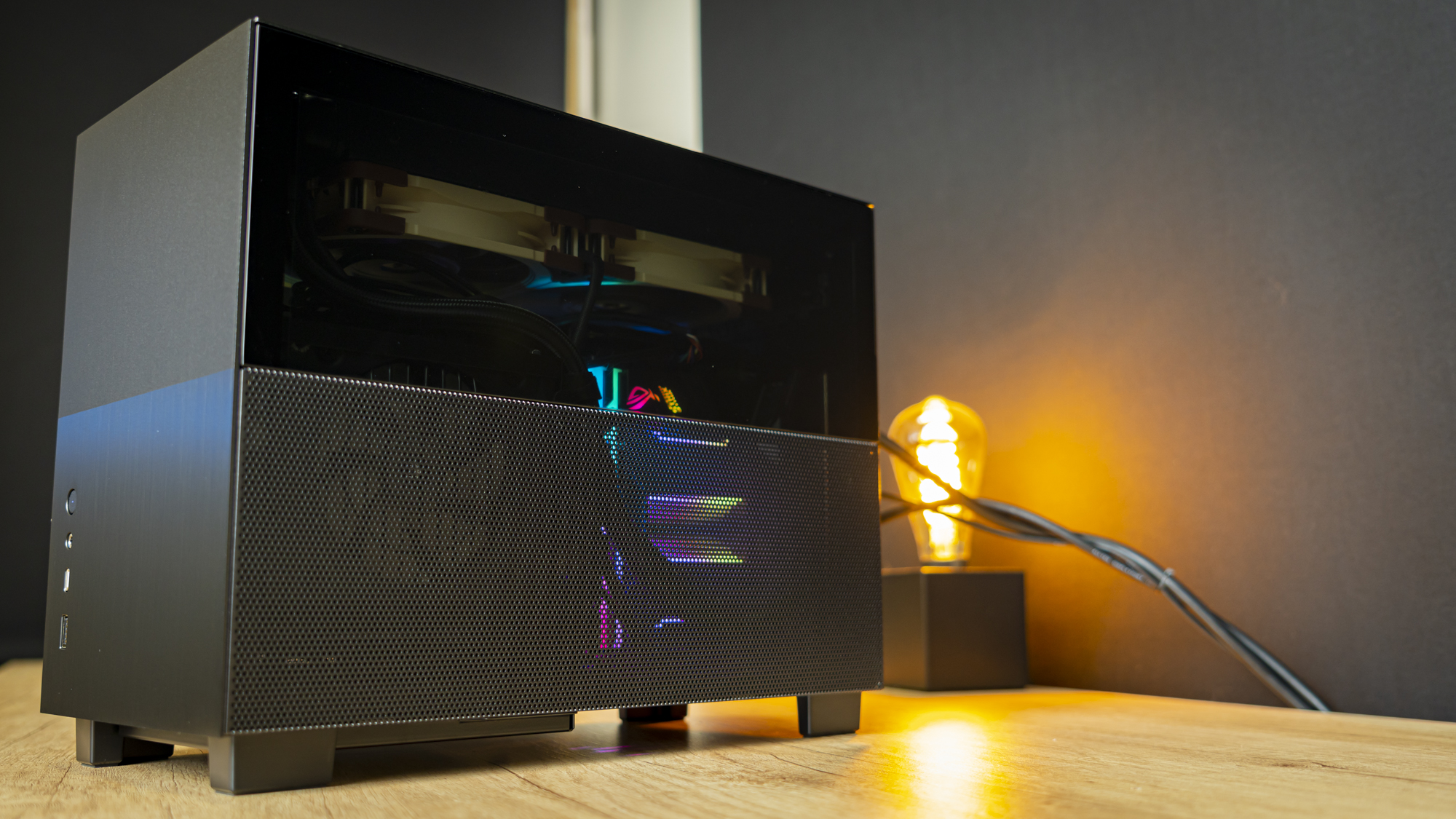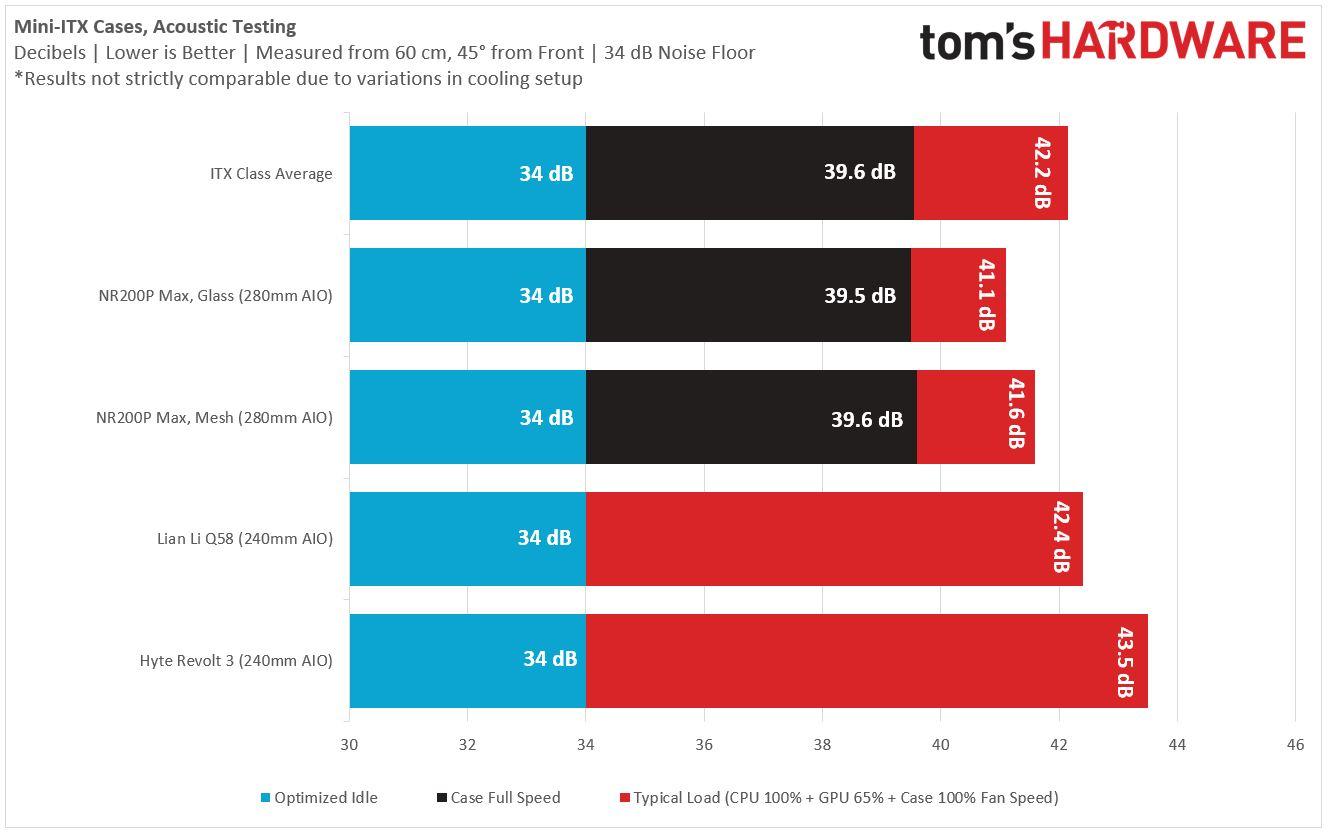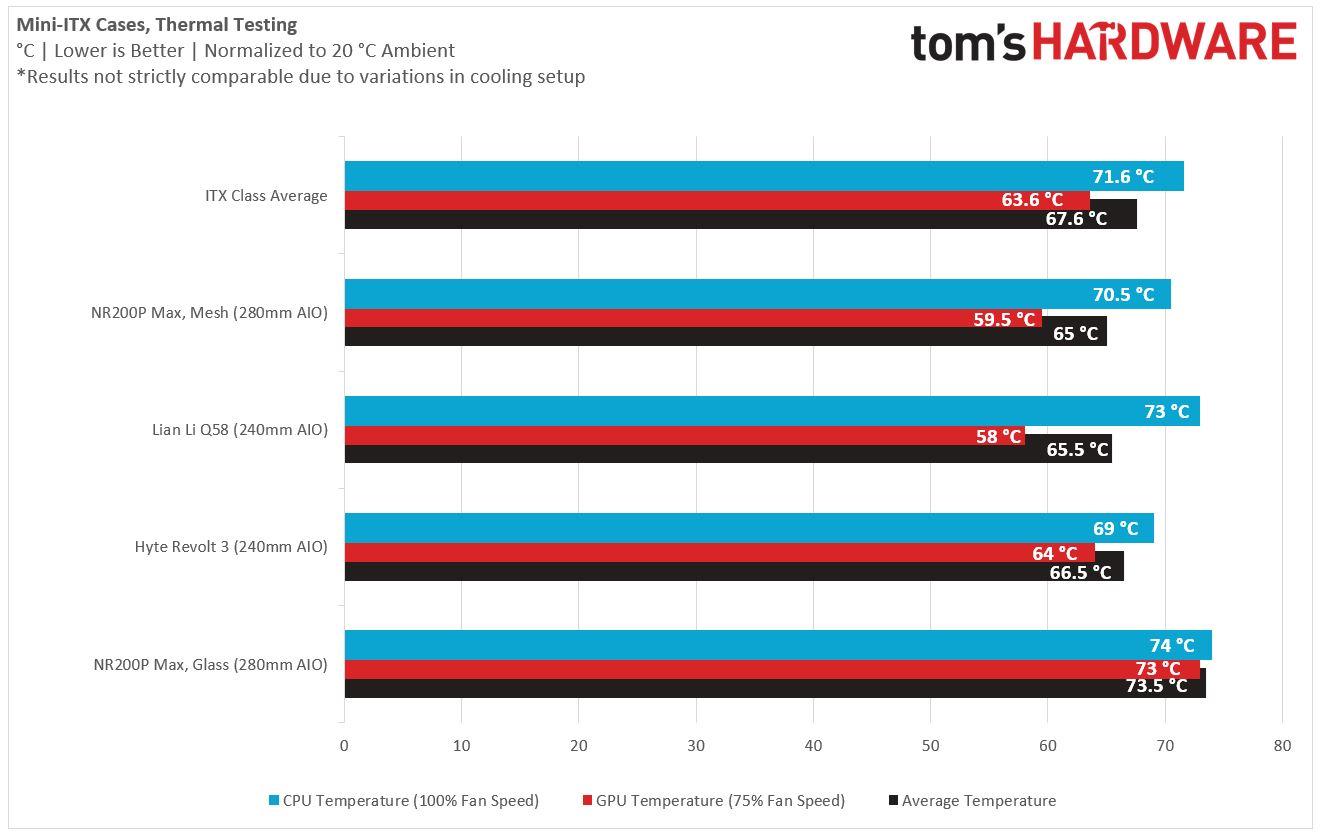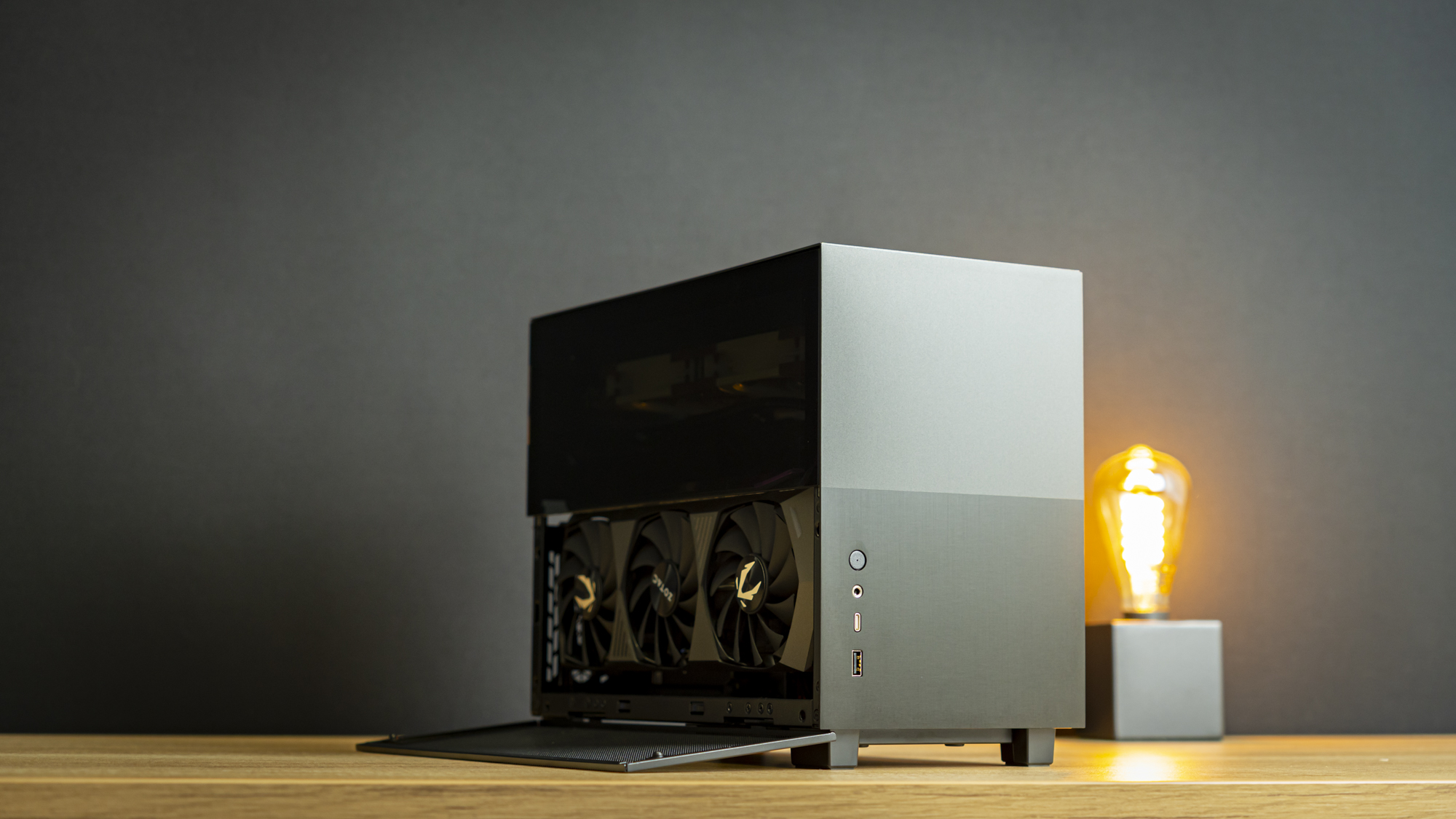Why you can trust Tom's Hardware
Although the Q58 doesn’t ship with any fans, it shouldn’t need any either. The GPU is pressed tight against the intake mesh on the side, and the AIO at the top, if you’re using one, takes care of the CPU and system exhaust. A 120mm fan can be added at the bottom for intake if so desired, but I’m not testing with one today as it isn’t essential.
We are using an updated testing methodology first introduced with the Cooler Master NR200P Max here, which involves new settings, more realistic acoustic tests, and worst-case-scenario thermal tests. For CPU cooling, we’re using the biggest AIO that I have available at the time of testing, allowing you to get a better idea of the thermals you can expect in a typical build intended for the case.
Acoustic Results
As far as acoustics go, the Q58 performs alright but not great. It’s quieter than the Hyte Revolt 3 even with an identical setup, though that’s likely due to the different GPU and AIO orientation. Naturally, the Cooler Master NR200P Max was quieter, but that’s because it was tested with its included 280mm AIO, which has quieter fans that spin at lower maximum speeds.
Thermal Results
When it comes to thermals, the Lian Li Q58 performs better than average, only being outperformed by the NR200P Max when it was using a mesh panel, and even then, it’s only by a sliver. The Q58 does witness a slightly higher CPU temperature, but its GPU temperature is impressive at 58 °C when normalized to a 20 °C room.
Of course, keep in mind with that with this thermal test, the CPU’s clock speed is locked at 4.0 GHz at 1.2V, and the GPU’s fan speeds are locked at 75% to ensure it can meet its power target – in practice, you’ll witness lower CPU temperatures and higher GPU temperatures due to the behavior of the boost algorithms.
Testing the PCIe 4.0 Riser Cable
To test the PCIe 4.0 riser cable, I simply set the PCIe mode in the BIOS to Gen 4, boot the system, run Furmark, and check whether it’s running at Gen 4 speeds in GPU-Z. If the cable makes it through this simple test, it gets our thumbs up, and the Gen4 cable that comes with the $160 Q58 made it through this test without issue.
Conclusion
To wrap this one up, all I can say is that Lian Li has yet another winner on its hands. After the Lancool II Mesh Performance last year, and the PC-O11 Air Mini last week, the company is showing that it is more than capable of building impressive, stylish cases that perform well at impressively friendly price points. The secret appears to be ditching the all-aluminum designs, though some does remain here on specific bits of paneling for that distinct, luxurious Lian Li look.
Get Tom's Hardware's best news and in-depth reviews, straight to your inbox.
More specific to the Q58, this ITX case manages to squeeze a high-TDP build such as our system with an i5-11600K and an RTX 3080 Ti into an astonishingly tiny, 14.3 Liter enclosure, not only with a pleasant build process and great looks, but also above-average thermal performance. And there is some room for improvement: We only used a 240mm AIO, but you can bump that up to a 280mm unit and add an intake fan for even better performance.
Conversely, if you’re on a budget, you can opt for the simple version with just a PCIe 3.0 riser cable, convert it to support your old ATX PSU, throw in a cheap 120mm AIO, and the end result will look just the same as ours thanks to the dark tint on the glass.
Priced at $130 for the base variant, with a $30 premium to jump to a PCIe 4.0 riser cable, and a $10 premium for the white finish, the Lian Li Q58 ITX case gets an easy recommendation. We only wish the GPU end of the riser cable was a bit stronger or better supported. Hopefully Lian Li will make that change.
Niels Broekhuijsen is a Contributing Writer for Tom's Hardware US. He reviews cases, water cooling and pc builds.
-
Geef There is a damn good reason for NOT allowing a side with vents. Imagine your playing a game and bump! Whoops your Pepsi just tipped over and splashed right into that vent and this case has the video card right there with fans spinning to spray that liquid all over the inside of the case!Reply -
deesider Reply
That's no problem buddy, the panels are removeable, just pop them straight into the dishwasher.Geef said:There is a damn good reason for NOT allowing a side with vents. Imagine your playing a game and bump! Whoops your Pepsi just tipped over and splashed right into that vent and this case has the video card right there with fans spinning to spray that liquid all over the inside of the case!
If it happens alot, maybe invest in some sort of GPU diaper for those little accidents -
Geef Reply
No, only the ones who expect business from myself and other folks who have thought of it.King_V said:Is this a problem that is routine enough that you expect all PC cases to address it? -
Questors ReplyGeef said:There is a damn good reason for NOT allowing a side with vents. Imagine your playing a game and bump! Whoops your Pepsi just tipped over and splashed right into that vent and this case has the video card right there with fans spinning to spray that liquid all over the inside of the case!
Have you tried moving the drink away from the PC chassis? If you are clumsy like me and constantly knock things over, this prevents the liquid contents from spilling into or onto your PC. There are also many covered drinking cup solutions on the market from 99 cents all the way up to several hundred dollars depending on your tastes and wallet. Some cups offer the benefit of keeping your drink cold or hot for a much longer time.
Then again, all products are not for all people. ITX chassis is lesson in packing as much as one can into a small space. Air flow or cooling, in general, is paramount. Even if the case will accept an AIO and the builder uses one, there are other components that needs cooling. A bottled up ITX case is bad news even more so than a larger case.
As for the case, it is very nice really and has been thoughtfully designed. It is now one of the few being considered for the wife's new build. That is IF GPU availability improves and prices come down. -
escksu ReplyGeef said:There is a damn good reason for NOT allowing a side with vents. Imagine your playing a game and bump! Whoops your Pepsi just tipped over and splashed right into that vent and this case has the video card right there with fans spinning to spray that liquid all over the inside of the case!
Hope you know that without those vents, the GPU will overheat due to lack of ventilation. The fans will not be able to work because its only 1cm or less from the panels.
If there are no vents, only blower style coolers will work because hot air is expelled out of the rear of the casing instead of within. -
Findecanor Reply
If you're right-handed, place the PC on the left side of the desk, and keep your drinks on the right side of the desk with monitor and keyboard in the middle.Geef said:There is a damn good reason for NOT allowing a side with vents. Imagine your playing a game and bump! Whoops your Pepsi just tipped over and splashed right into that vent and this case has the video card right there with fans spinning to spray that liquid all over the inside of the case! -
ThunderBuddy ReplyGeef said:There is a damn good reason for NOT allowing a side with vents. Imagine your playing a game and bump! Whoops your Pepsi just tipped over and splashed right into that vent and this case has the video card right there with fans spinning to spray that liquid all over the inside of the case!
This has to be, without a doubt, the absolutely most nonsensical/strangest comment I have ever read in my life. Just yikes. First of all, you shouldn't have any liquids anywhere near your PC, if you put your drink right in front of your pc you legitmately have the IQ of a toad. Secondly, stop drinking soda pop. It's horrible for you. And lastly, not everyone is uncoordinated and careless, generally most people don't knock their drinks over on a regular basis. It seems like you have a lot of issues here and I suggest you work them out instead of formulating erroneous and nonsensical replies to people's posts. -
ThunderBuddy ReplyGeef said:No, only the ones who expect business from myself and other folks who have thought of it.
you are on an island of idiocy there my friend, so there are no other "ones" you speak of -
Geef Reply
Answer to King V: Yes I do think in general side vents are a bad idea. They are popular for random Gamer PC from local store! "Look it has a side vent. It must be better!"King_V said:Is this a problem that is routine enough that you expect all PC cases to address it?
---
Everyone who responds to this seems to hate the idea a side vent is a bad in general. In my OP I explained in detail. However other posters never seem to explain why, you only tell me what and how to drink near a PC.
deesider did his best by explaining what to do after a drink spill. Thanks
escksu mentioned how it wouldn't work without a vent.
escksu said:without those vents, the GPU will overheat due to lack of ventilation.
This case has fans on bottom and top so its an upward flow case. It does look cramped inside so that might be the reason for the side vent. Good reason, but most cases out there just had a side vent because they can and it looks cool, no airflow reason.
thunderbuddy just wanted to release his hate on me:
ThunderBuddy said:First of all, you shouldn't have any liquids anywhere near your PC
Captain Obvious strikes again! Like 98% of the people using PCs would have to stop if that rule was followed. Relax thundergirl, telling me not to drink soda pop does nothing to help the conversation. If yelling hateful things at me makes you relax then go for it, knock yourself out. After your done look back at my pic, I'm still smiling.





